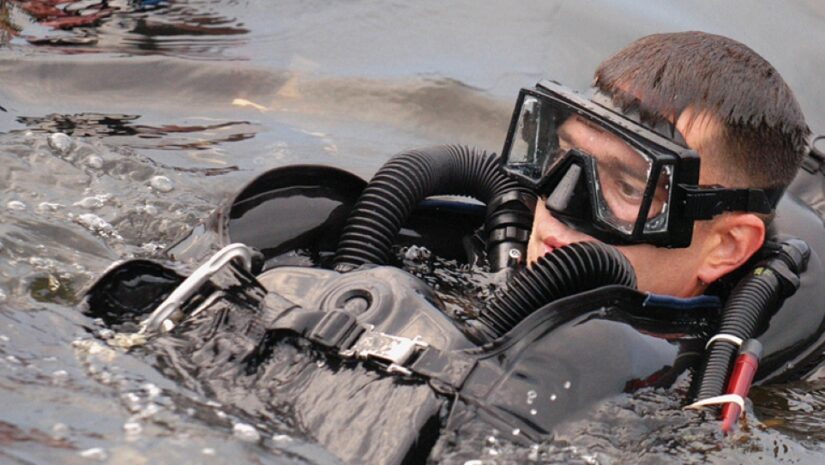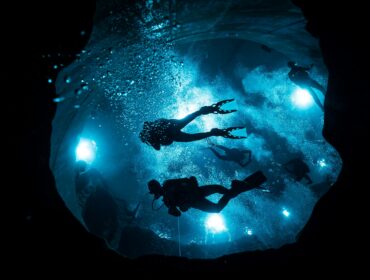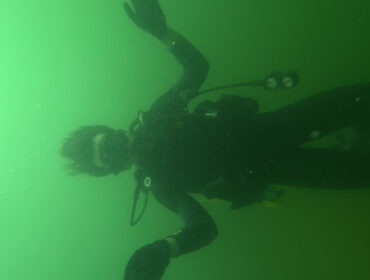At some point in their diving journey, many divers begin to wonder if rebreathers are worth the switch. Open circuit scuba is simple, reliable, and what most of us first learned on. However, it has its limits when it comes to gas efficiency, dive duration, and stealth underwater.
Rebreathers, on the other hand, offer extended bottom times and a bubble-free experience, but they bring extra cost, training, and responsibility.
This article breaks down the key differences between rebreather vs open circuit diving. Whether you’re curious about the benefits of rebreathers or just want a clear comparison of both systems, you’ll find the information here to help you decide what’s right for your diving goals.
What Is Open Circuit Diving?
Open circuit scuba diving is the system most divers start with. When you inhale, your regulator delivers air from the tank at the surrounding water pressure. When you exhale, that used air is released as bubbles into the water – hence the name “open circuit,” because the gas leaves the system rather than being reused.
An open circuit setup is relatively straightforward: a cylinder, a regulator with first and second stages, a buoyancy compensator, and gauges or a dive computer. This simplicity makes it reliable, easy to maintain, and accessible almost anywhere in the world. If something goes wrong, the response is usually straightforward: switch to an alternate air source, abort the dive, or surface.
For most recreational divers, open circuit scuba is more than enough. It’s affordable, requires less training, and has predictable failure modes. The downsides are limited gas efficiency and reduced bottom time, especially on deep dives where gas consumption rises rapidly. Divers interested in photography or marine life encounters also find the constant stream of bubbles can disturb shy species or make a stealthy approach impossible.
Imagine you’re on a wreck at 40 meters: with open circuit, your air supply ticks away quickly, and you’re acutely aware of your turn pressure. That means shorter bottom times and more conservative dive planning compared to what might be possible with other systems.
What Is Rebreather Diving?
Rebreather diving takes a very different approach to delivering breathing gas. Instead of venting exhaled air into the water, the system recycles it. When you exhale, your breath passes through a scrubber filled with a chemical absorbent that removes carbon dioxide. Oxygen is then added back in small amounts to maintain the right mix, and the loop delivers the refreshed gas back to you. This creates a “closed circuit,” where very little is wasted.
A rebreather setup is more complex than open circuit. Key components include counterlungs (which act like small reservoirs of breathing gas), the CO₂ scrubber, sensors and electronics that monitor oxygen levels, and a bailout system in case of failure. Some models are electronically controlled (eCCR), while others are manual (mCCR), but all require the diver to pay close attention throughout the dive.
The benefits are hard to ignore: incredible gas efficiency, especially on deeper dives; extended bottom times; and a quiet, bubble-free experience that’s ideal for photography, scientific research, or encounters with shy marine life. The trade-offs come with responsibility.
Rebreathers are expensive, require meticulous pre-dive checks, and demand specialized training. They also introduce unique risks such as hypoxia, hyperoxia, or CO₂ buildup, which aren’t factors on open circuit.
Picture this: instead of bubbles scattering a school of hammerheads, you hang silently in the blue, unnoticed. The dive lasts far longer than your open circuit buddy’s, but every minute requires focus and trust in your equipment. That’s the rebreather difference.
Comparing Rebreather vs Open Circuit Diving
Choosing between rebreather vs open circuit diving isn’t simply about equipment. It’s about how you want to dive. Each system changes your relationship with gas, time, training, cost, and even the way marine life reacts to you underwater. By breaking the comparison down into key factors, it’s easier to see which approach best matches your diving goals.
Gas Efficiency and Bottom Time
Gas use is one of the clearest differences between the two systems. On open circuit, every exhalation is lost to the water. The deeper you go, the more gas you consume, and bottom time becomes limited by the size of your cylinder and your surface air consumption rate. That’s why deep wreck or cave dives often require multiple cylinders or staged decompression gas.
Rebreathers, by contrast, recycle the breathing mix. Oxygen is added in small amounts as it’s metabolized, which makes the system highly efficient. A rebreather diver can spend hours underwater on a single dive with far less gas volume compared to an open circuit setup. This efficiency becomes especially valuable on deep technical dives where carrying enough open circuit gas would be impractical.
Noise, Stealth, and Wildlife Interaction
Bubbles may feel like part of the soundtrack of scuba, but they can be a drawback. On open circuit, every exhalation releases a noisy burst of bubbles, which not only gives away your position but can also spook fish, shy marine mammals, or other sensitive wildlife. For underwater photographers and videographers, those bubbles sometimes drift right into the frame, ruining an otherwise perfect shot.
Rebreathers, on the other hand, are almost silent. With no bubbles escaping on each breath, you move through the water far more stealthily. This makes rebreathers especially appealing for scientific research, wreck exploration, or divers who want close encounters with marine life. The quiet approach allows you to blend in, observe natural behaviors, and capture images or data that would be difficult to achieve with open circuit gear.
Training and Skills Required
Open circuit training is designed to be straightforward and accessible. An entry-level certification teaches you everything needed to safely use the equipment, manage buoyancy, and respond to common emergencies. Beyond that, advanced and specialty courses build on the same foundation, but the equipment itself doesn’t become more complex. Once you’ve learned the basics, diving open circuit rarely demands constant attention to the gear.
Rebreathers are very different. Even the entry-level training requires more time, more focus, and a willingness to learn detailed procedures. Divers must monitor oxygen levels, check scrubber life, and be ready to respond instantly if a problem arises. Mistakes that would be minor on open circuit – like skipping a checklist – can have serious consequences on a rebreather. For that reason, training doesn’t just cover the equipment but also emphasizes discipline, situational awareness, and emergency protocols.
This level of commitment means rebreather diving isn’t for everyone. It suits divers who enjoy precision, detail, and constant engagement with their kit, rather than those who prefer a more relaxed, “set it and forget it” style of diving.
Cost and Maintenance
One of the biggest dividing lines between open circuit and rebreather diving is the price tag. Open circuit equipment is relatively affordable: a cylinder, regulator set, BCD, and gauges or a dive computer. Maintenance is straightforward with annual servicing for regulators, visual or hydrostatic inspections for tanks, and routine checks before each dive. Once purchased, costs mostly come from air fills, which are inexpensive and widely available.
Rebreathers sit at the other end of the spectrum. The initial purchase price is several times higher than an open circuit setup, and ongoing costs add up quickly. Sofnolime or other CO₂ scrubber material must be replaced regularly, oxygen sensors have a limited lifespan, and servicing requires specialized technicians. On top of that, pre-dive preparation is more time-consuming: every O-ring, sensor, and connection has to be checked with care.
For divers considering the switch, the cost isn’t just financial, it’s also the investment of time. Owning a rebreather means accepting that part of your diving hobby will be dedicated to meticulous setup, breakdown, and servicing before and after every dive.
Safety Considerations
Safety is often where the two systems differ most in perception and practice. Open circuit scuba is generally considered more forgiving. If something fails, like a regulator free-flows, a hose leaks, or you run low on gas, the response is simple: switch to an alternate source, abort the dive, and ascend. Failures are predictable and usually easy to manage, especially with a buddy.
Rebreathers, however, come with unique hazards. Because the breathing gas is managed inside a closed loop, issues like hypoxia (too little oxygen), hyperoxia (too much oxygen), or carbon dioxide buildup can occur without obvious warning. These problems can become life-threatening quickly if not caught in time. That’s why rebreather divers rely on redundant monitoring, strict checklists, and disciplined dive practices to stay safe.
It’s worth noting that while rebreathers do carry higher risks, those risks are manageable with training, attention, and a cautious mindset. Experienced rebreather divers often say the equipment rewards precision but punishes complacency.
Should You Switch to a Rebreather?
The decision to move from open circuit to a rebreather depends on your diving goals, budget, and personality as a diver. Rebreathers aren’t automatically “better”. They’re tools suited to specific types of diving.
Divers who benefit most are those pushing into technical depths, spending long durations underwater, or seeking close encounters with marine life. Underwater photographers, videographers, and scientific researchers often find the investment worthwhile because the extended bottom times and bubble-free experience open new opportunities that open circuit simply can’t provide.
Ultimately, the question isn’t “should I switch?” but rather “what kind of diving do I want to do?” If your goals align with the advantages of rebreathers and you’re ready to commit to the extra training and responsibilities, the switch can be transformative. If not, open circuit remains a perfectly capable and enjoyable way to explore the underwater world.
On the other hand, recreational divers who log only a handful of dives each year may find rebreathers more trouble than they’re worth. The cost, training, and maintenance don’t make sense for someone who prefers relaxed vacation dives where simplicity and reliability are the priority.
Final Thoughts
Open circuit and rebreather diving each have their place in the underwater world. Open circuit is simple, accessible, and dependable – the system that gets most divers started and continues to serve the majority of recreational diving needs. Rebreathers, meanwhile, unlock longer bottom times, quieter dives, and new opportunities, but they demand significant investment, discipline, and a willingness to take on more responsibility.
The choice isn’t about which system is “better” but about which one matches your diving style, ambitions, and resources. For some, the reliability and ease of open circuit make it the lifelong choice. For others, the allure of rebreather diving – extended exploration, silent encounters, and technical depth – makes the switch worthwhile.
Whichever path you choose, both systems share the same ultimate goal: to give divers safe and unforgettable access to the underwater world.






